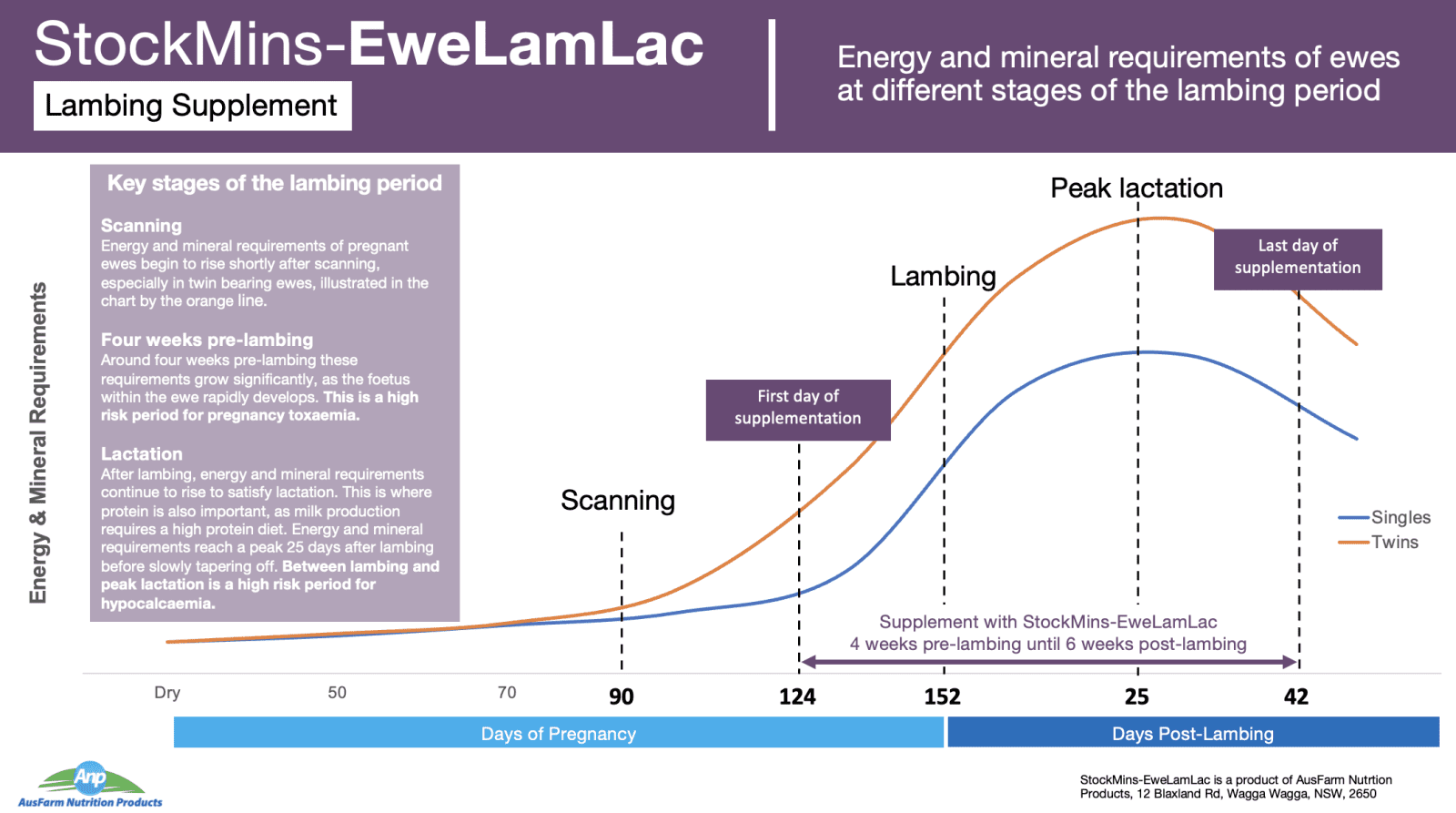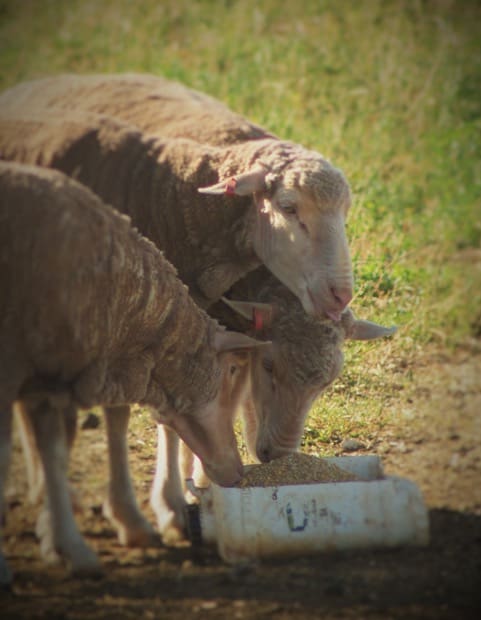WITH over 45 years’ experience in sheep production and nutrition, and working with producers running commercial sheep flocks, AusFarm Nutrition Products’ chief nutritionist, Dr Paul Meggison believes he has found a way to improve lambing results.
The lambing period, from scanning through to mid-lactation, is without doubt the most critical time for any sheep breeding operation, as management of ewes and lambs throughout this period can determine the success or failure of the sheep enterprise.
Mortality of ewes and lambs during the lambing period is the largest cause of lost productivity and the greatest expense to sheep production systems annually.
Mortality during lambing is generally diagnosed as peri-natal mortality, dystocia, hypocalcaemia and pregnancy toxaemia which combined account for almost $1 billion in lost production to the industry annually.
At the individual farm level, it is not foreign to see scanning rates of 130 percent to 140pc result in weaning percentages of 80pc and 90pc, with the average lamb producing operation experiencing lamb mortalities of 10pc to 35pc.1
Interestingly, when investigating the cause of peri-natal mortalities, a combination of mismothering, starvation, stillbirth and dystocia was believed to account for 55% of lamb losses. Single born lambs were more likely to die from dystocia and stillbirth, while twin lambs were more likely to die from starvation, mismothering and a birth injury.2
Although there are many variables that may lead to mortality in pregnant ewes and newborn lambs, birth weight is the largest determinant of lamb survival, and is strongly linked to maternal nutrition.3 Similarly, hypocalcaemia and pregnancy toxaemia are metabolic diseases arising from nutritional deficiencies that can be corrected with effective supplementation.
With over 45 years experience in sheep production and nutrition, and working with producers running commercial sheep flocks, AusFarm Nutrition Products’ Chief Nutritionist, Dr Paul Meggison believes he has found a way to improve lambing results.
“Like any business where continual improvement is a focal point, we have identified key areas of a sheep production system where small changes can make a significant difference to performance” he said.
Dr Meggison identifies the 110-day period from seven weeks pre-lambing until six weeks post-lambing as the period where a significant amount of upside can be gained in a sheep breeding operation.
“Although there are many areas for improvement in any production system, we are interested in hitting the area where producers can make the largest impact for the smallest amount of effort first.
“That’s the period from scanning through to mid-lactation.”
Dr Meggison highlights the key areas he believes are critical to improving lambing results. He refers to them as lambing critical control points.
Lambing critical control points
- Scanning – Scanning for multiples and separating multiple bearing ewes from singles and treating with extra care.
- Effective animal health management – Drench and vaccinate between day 110 and day 125 of pregnancy.
- Feeding to requirements – Maintain a stable body condition score of between 3 and 3.5. Increase feed value up until lambing, saving the best feed for lambing. Ample amounts of lush, high value green feed would be enough for single bearing ewes (supplement with grain from four weeks pre-lambing if pasture is lacking quality). Twin bearing ewes may require grain supplementation regardless of pasture quality.
- Essential minerals, vitamins and trace elements – The use of an effective complete lambing supplement like StockMins-EweLamLac should be offered from at least 4 weeks pre lambing (day 125) until four to six weeks post-lambing to correct deficiencies and reduce stress. If grazing wet paddocks where hoof health is a concern, StockMins-Hoof n Horn can boost mineral levels and support hoof growth and structure.
- Lambing paddocks and flocks – Ideally lambing paddocks should contain wind breaks and shelter and lambing flocks should be limited to 200 ewes for twins and 500 ewes for singles.
“Each critical control point offers an opportunity for an improvement to the operation that in my opinion can significantly alter the success of lambing. All control points are interrelated and compounding, where each has a positive effect on the next” he said.
According to Dr Meggison, nutritional supplementation is commonly overlooked to the detriment of the businesses bottom line.
“With the value of sheep meat over recent years, a one percent, two percent or five percent increase in the survival rate of lambs can generate thousands of dollars in previously unrealised profit, and the use of an effective mineral supplement during lambing can make this happen.”
“Like with energy, between late pregnancy and peak lactation, the outflow of minerals, vitamins and trace elements from the ewe into the lamb massively outstrips supply from feed alone.”
Extreme deficiencies can lead to hypocalcaemia and pregnancy toxaemia, however, well before they hit critical levels, mineral deficiencies reduce the efficiency of essential bodily functions, leading to low immunity, poor production and stress.
Stressed ewes with poor mineral reserves and low immunity are more likely to lose lambs due to mismothering, starvation, dystocia and stillbirth.
Dr Meggison states that “Not all supplements are equal, and not all supplements generate the same results”.
StockMins-EweLamLac is a weatherproof, granular, mineral supplement designed to supply pregnant and recently lambed ewes with balanced levels of essential minerals, vitamins and trace elements to assist in correcting deficiencies and boosting reserves during times of high demand.
A recent independent trial performed by Anthony Shepherd from the livestock consulting group Sheepmatters, highlighted the significant value in supplementing pregnant ewes with a complete lambing supplement. “For 1,000 ewes supplemented the difference in revenue can be upwards of $16,000.”
Sheepmatters trial: StockMins-EweLamLac HE lambing supplement vs Causmag, lime and salt
A recent independent study, performed by Anthony Shepherd of the livestock consulting group Sheepmatters, compared the performance of ewes supplemented with Causmag (magnesium oxide), lime and salt (288 single bearing ewes) with ewes supplemented with StockMins-EweLamLac HE (197 single bearing ewes) over a 98-day period from 4 weeks pre-lambing until 4 weeks post-lambing.
Each supplement was offered free-access to livestock on an ad lib basis, ensuring all animals had access to supplement as required.
The average liveweights of all lambs and ewes were compared at scanning (ewes only), lamb marking and weaning. Lamb mortality data were also collected on a daily basis. These measurements were used as key performance indicators (KPI’s) of each trial group.
Summary of results
The trial group offered StockMins-EweLamLac HE performed significantly better across all KPI’s including:
- 3p more lambs weaned
- An average of 6.1kg heavier lambs at weaning
- An average of 4.8kg heavier ewes at weaning
What does this mean to the bottom line?
For 1000 single bearing ewes over a 98-day supplementary period (4 weeks pre-lambing, six weeks lambing period and four weeks post-lambing), a sheep breeding operation can realise a $16,568 net income difference by supplementing with StockMins-EweLamLac HE over Causmag, lime and salt.
| Cost of supplement | Revenue* | Net Income | |
| StockMins-EweLamLac HE | $5,930^ | $93,635 | $87,705 |
| Causmag, lime and salt | $1,000# | $72,137 | $71,137 |
| Difference | -$4,930 | $21,498 | $16,568 |
Click here for full trial summary.
Conclusion
Supplementing ewes from 4 weeks pre-lambing until six weeks post-lambing with StockMins-EweLamLac HE significantly improves lambing performance when compared to supplementing ewes with Causmag (magnesium oxide), lime and salt.
Please contact AusFarm Nutrition Products on 0412 048 055 or visit www.ausfarmnutrition.com for more information on how StockMins-EweLamLac can help boost your lambing results this season.
StockMins-EweLamLac is available for purchase from selected rural resellers. Click here to find a store near you, or contact our team to organise distribution through your local store.
- Priority list of endemic diseases for the red meat industry – 2022 update. Meat and Livestock Australia, 2022. 2. Refshauge G, Brien FD, Hinch GN, van de Ven R (2016) Neonatal lamb mortality: factors associated with the death of Australian lambs. Animal Production Science 56, 726–735. doi:10.1071/AN15121. 3. Oldham CM, Thompson AN, Ferguson MB, Gordon DJ, Kearney GA, Paganoni BL (2011) The birthweight and survival of Merino lambs can be predicted from the profile of liveweight change of their mothers during pregnancy. Animal Production Science 51, 776–783. doi:10.1071/ AN10155. Causmag is a registered product of Causmag International. StockMins-EweLamLac HE, StockMins-EweLamLac and StockMins-Hoof n Horn are products of AusFarm Nutrition Products.




HAVE YOUR SAY